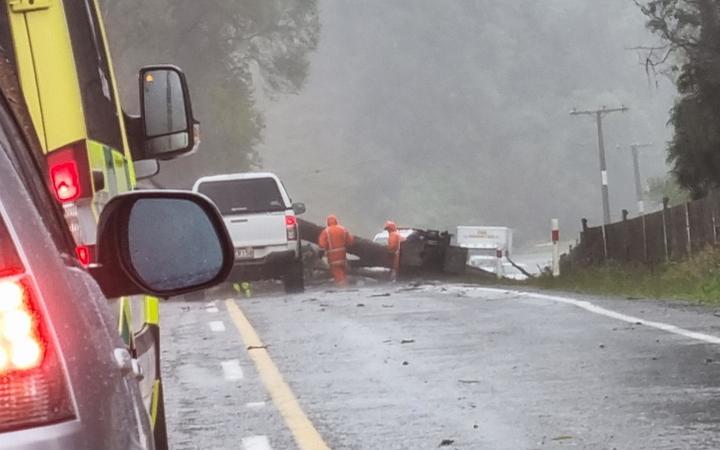
The storm that blasted the East Coast of the North Island yesterday is moving away from the country and the rain has mostly cleared, and Tairāwhiti and Wairoa residents face another day of cleanup.
Most of State Highway 35 from Gisborne to the East Cape has now reopened, though the road from the turnoff to Ruatoria to just north of Tikitiki remains closed.
The section between Tokomaru Bay and Te Puia Springs will continue to close overnight. It is still down to single lanes in some places, with sections of unsealed road, signs, cones and temporary speed limits.
Waka Kotahi spokesperson Helen Harris told Morning Report the agency was prioritising state highways because Eastland contractors need access to restore power to outlying communities.
"We're progressively hoping to open throughout the day," Harris said.
"We have crews that are going north and south to open the roads.
"There are multiple trees, and they are big trees, that have come down and they are blocking the whole network."
MetService meteorologist Daniel Corrigan said it had been a major deluge, especially coming on top of widespread flooding in Tairāwhiti three weeks ago.
The hardest hit area was around East Cape where there was 200mm of rain between Tuesday evening and Wednesday midnight - with 50mm of that falling in just two hours between 10am and midday on Wednesday.
Tokomaru Bay-based civil defence coordinator Lillian Te Hau-Ward said the weather wasn't as bad as expected.
"Everyone is fine ... the sea is no longer roaring, it's no longer raining and the wind has died down."
Te Hau-Ward said a Tokomaru Bay contractor saved three properties from flooding after a small stream turned into a raging torrent, spending four hours clearing the debris.
There were road closures, power lines were down, and some cellphone communications were down, she said.
Gisborne District Council said crews headed out at first light to clear trees from roads and restore power to around 2300 homes across the region.
Overnight wind gusts reached 100km/h at Pouawa, between Gisborne and Tolaga Bay, causing trees to fall on to roads
In a statement, council's chief executive Nedine Thatcher Swann urged anyone who did not have to travel to stay home.
Emergency sewer valves were closed at 9.25am this morning and discharge has stopped. The council advised no swimming, fishing or gathering shellfish in rivers and beaches until at least five days after the valves are closed, and warning signs were removed.
In Tairāwhiti, the East Cape lighthouse received the most rain in the 24 hours to 8.45am Thursday, with 139.5mm, followed by the Whareratas between Gisborne and Wairoa with 132.6mm and Panikau Rd between Gisborne and Tolaga Bay with 124mm.
Rainfall was lighter in Gisborne itself, with 56mm recorded at Stout Street, 55.2mm at the airport and 65mm at Wheatstone Road.
In Hawke's Bay, Pukeorapa Station, near Mōrere between Wairoa and Gisborne, had 157mm of rain over 24 hours.











